.gif)
List of Butterflies of North America (Nymphalidae)
Encyclopedia
Subfamily Libytheinae: Snouts
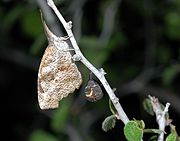
- American Snout, Libytheana carinenta
Subfamily Heliconiinae: Heliconians and Fritillaries

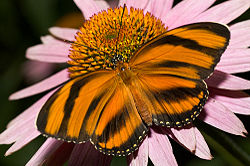
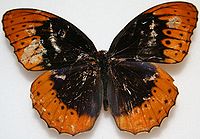
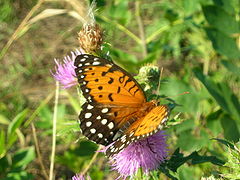
- Gulf Fritillary, Agraulis vanillae
- Mexican Silverspot, Dione moneta
- Banded Orange Heliconian, Dryadula phaetusaDryadula phaetusaDryadula phaetusa, also known as the Banded Orange Heliconian, Banded Orange, or Orange Tiger, is a species of butterfly . The sole representative of its genus, the Banded Orange Heliconian is native from Brazil to central Mexico, and in summer it can be found rarely as far north as central Kansas...
- Julia Heliconian, Dryas iulia
- Least Heliconian, Euiedes aliphera
- Isabella's Heliconian, Eueides isabella
- Zebra Heliconian, Heliconius charithonia
- Erato Heliconian, Heliconius eratoHeliconius eratoThe Red Postman is one of about 40 Neotropical species of butterfly belonging to the genus Heliconius. It is also commonly known as the Small Postman, the Red Passion Flower Butterfly, or the Crimson-patched Longwing.-Description:The species is remarkably variable in colour and form throughout...
- Tiger Heliconian, Heliconius ismeniusHeliconius ismeniusHeliconius ismenius, also called the Ismenius Tiger or Tiger Heliconian, is a butterfly found in Central America and northern South America. They are highly populous as south as Ecuador and Venezuela and as north as southern Mexico, Guatemala and Belize. The H. ismenius are more commonly called...
- Variegated Fritillary, Euptoieta claudiaEuptoieta claudiaThe Variegated Fritillary is a North and South American butterfly in the family Nymphalidae. Even though the Variegated Fritillary has some very different characteristics from the Speyeria Fritillaries, it is still closely related to them. Some of the differences are: Variegated Fritillaries have...
- Mexican Fritillary, Euptoieta hegesiaEuptoieta hegesiaThe Mexican Fritillary is a North and South American butterfly in the family Nymphalidae.-Description:The upper side of the wings is bright orange with the basal part of the hind wing unmarked. There is a row of submarginal black spots on both the fore wing and the hind wing. The underside of...
- Diana Fritillary, Speyeria diana
- Great Spangled Fritillary, Speyeria cybele
- Speyeria cybele leto
- Aphrodite Fritillary, Speyeria aphrodite
- Regal Fritillary, Speyeria idalia
- Nokomis Fritillary, Speyeria nokomis
- Edward's Fritillary, Speyeria edwardsi
- Coronis Fritillary, Speyeria coronisSpeyeria coronisThe Coronis Fritillary is a butterfly of the Nymphalidae family of North America. It is common from Baja California to Washington and west to Colorado and western South Dakota and once reported in Alberta....
- Zerene Fritillary, Speyeria zereneSpeyeria zereneZerene Fritillary is a species of butterfly found in the western portions of the United States and Canada.-Description:...
- "Spring Mountains" Zerene Fritillary, Speyeria zerene carolae
- Callippe Fritillary, Speyeria callippeSpeyeria callippeThe Callippe Fritillary is a fritillary from North America.Larva feed on Viola pedunculata and Viola nuttallii.-Subspecies:Listed alphabetically.*S. c. calgariana...
- Speyeria callippe nevadensis
- Great Basin Fritillary, Speyeria egleis
- Unsilvered Fritillary, Speyeria adiasteSpeyeria adiasteThe Unsilvered Fritillary or Adiaste Fritillary is a species of butterfly of the Nymphalidae family. It is found from California County north to San Mateo County and east to north Los Angeles County and Kern County....
- Atlantis Fritillary, Speyeria atlantisSpeyeria atlantisThe Atlantis Fritillary is a butterfly of the Nymphalidae family of North America. It is from the Avalon Pennisula of Newfoundland and Labrador to northern British Columbia, across northern United States south as far as Colorado and West Virginia...
- "Atlantis" Atlantis Fritillary, Speyeria atlantis atlantis
- "Hesperis" Atlantis Fritillary, Speyeria atlantis hesperis
- "Southwestern" Atlantis Fritillary, Speyeria atlantis nausicaa
- Hydaspe Fritillary, Speyeria hydaspeSpeyeria hydaspeHydaspe Fritillary is a species of orange-brown butterfly found in the western portions of the United States and Canada. A small fritillary, it usually has cream-colored underwing spots, but the Vancouver Island subspecies has silver spots. It is similar to S. zerene and S...
- Mormon Fritillary, Speyeria mormoniaSpeyeria mormoniaThe Mormon Fritillary is a butterfly of the Nymphalidae family of North America. It is common from northern California to British Columbia and west Saskatchewan, Colorado, and western South Dakota....
- Speyeria mormonia atronia
- Speyeria mormonia luski
- Mountain Fritillary, Boloria napaeaBoloria napaeaThe Mountain Fritillary is a butterfly of the Nymphalidae family. In Europe the species is found in the Alps, mountainous areas in northern Scandinavia and very local in the eastern parts of the Pyrenees. In North America it is found in Alaska, North-Western Canada and in small populations in the...
- Bog Fritillary, Boloria eunomiaBoloria eunomiaThe Bog Fritillary or Ocellate Bog Fritillary is a butterfly of the Nymphalidae family.-Description:The wings are orange-brown with dark markings. The color of the hindwings are orangish-brown with a tan postmedian band followed by a row of round silver spots. The length of the forewings is...
- Silver-bordered Fritillary, Boloria selene
- Meadow Fritillary, Boloria bellonaBoloria bellonaThe Meadow Fritillary, , is a North American butterfly in the brushfoot family, Nymphalidae. The common name, Meadow Fritillary, is also used for a European butterfly species, Melitaea parthenoides.-Description:...
- Frigga Fritillary, Boloria friggaBoloria friggaThe Frigga Fritillary is a butterfly of the family Nymphalidae with a circumboreal distribution. It occurs in bogs and tundra in Northern Europe to the north of 60° N, very locally in more southern locations, as well as in the Urals, Siberia, Northern Mongolia, the Russian Far East, western parts...
- Dingy Fritillary, Boloria improbaBoloria improbaThe Dingy Fritillary is a butterfly of the Nymphalidae family. In Europe it is only found in small parts of Scandinavia, more specifically the border region between Norway, Sweden and Finland...
- "Wind River" Dingy Fritillary, Boloria improba harryi
- "Uncompahgre" Dingy Fritillary, Boloria improba acrocnema
- Relict Fritillary, Boloria kriemhild
- Pacific Fritillary, Boloria epithoreBoloria epithoreThe Pacific Fritillary is a butterfly of the Nymphalidae family. It is found in western North America from California to British Columbia and Alberta.The wingspan is 34–44 mm. The butterfly flies from June to July....
- Polaris Fritillary, Boloria polarisBoloria polarisThe Polaris Fritillary is a butterfly of the Nymphalidae family. It is found in Northernmost Scandinavia, North America and in Greenland. It is also found in North Eastern Russia. It is one of only six butterfly species found on the Canadian Ellesmere Island.The wingspan is 32-38 mm...
- Freija Fritillary, Boloria freijaBoloria freijaThe Freija Fritillary is a butterfly of the family Nymphalidae with a circumboreal distribution. It occurs in bogs and tundra...
- Alberta Fritillary, Boloria albertaBoloria albertaThe Alberta Fritillary is a butterfly of the Nymphalidae family. It is found in Rocky Mountains of British Columbia and Alberta and in northern Montana.The wingspan is 35–45 mm...
- Astarte Fritillary, Boloria astarteBoloria astarteThe Astarte Fritillary is a butterfly of the Nymphalidae family. It is found from northwestern North America to northeastern Siberia. It is found as far south as Montana and Washington....
- "Distinct" Astarte Fritillary, Boloria astarte distincta
- Purplish Fritillary, Boloria montinus
- Arctic Fritillary, Boloria charicleaBoloria charicleaThe Arctic Fritillary or Purplish Fritillary is a butterfly of the Nymphalidae family. It is found in the northern part of the Palearctic ecozone and the Nearctic ecozone.The length of the forewings is 16–18 mm...
- Cryptic Fritillary, Boloria natazhatiBoloria natazhatiThe Beringian Fritillary, Cryptic Fritillary or Pleistocene Fritillary is a butterfly of the Nymphalidae family. It is found from northwestern Canada as far south as northern British Columbia....
Subfamily Nymphalinae: True Brushfoots
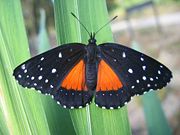
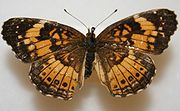
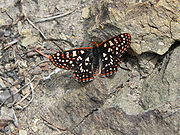
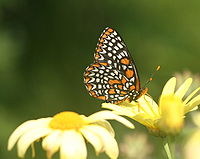
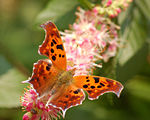
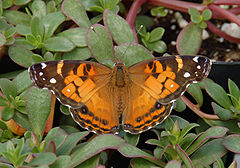

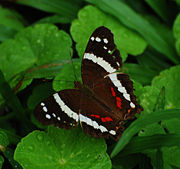
- Dotted Checkerspot, Poladryas minuta
- Arachne Checkerspot, Poladryas arachne
- Theona Checkerspot, Thessalia theona
- Chinati Checkerspot, Thessalia chinatiensis
- Black Checkerspot, Thessalia cyneas
- Fulvia Checkerspot, Thessalia fulvia
- Leanira Checkerspot, Thessalia leanira
- California Patch, Chlosyne californica
- Bordered Patch, Chlosyne laciniaChlosyne laciniaThe Bordered Patch is a North and South American butterfly in the family Nymphalidae.-Description:...
- Definite Patch, Chlosyne definita
- Banded Patch, Chlosyne endeis
- Crimson Patch, Chlosyne janais
- Rosita Patch, Chlosyne rosita
- Red-spotted Patch, Chlosyne melitaeoides
- Gorgone Checkerspot, Chlosyne gorgoneChlosyne gorgoneCommon names: Gorgone CheckerspotThe Gorgone Checkerspot is a species of Nymphalinae that occurs in North America.-Description:...
- Silvery Checkerspot, Chlosyne nycteisChlosyne nycteisCommon names: Silvery CheckerspotThe Silvery Checkerspot is a species of Nymphalinae that occurs in North America.-Description:Adult...
- Harris's Checkerspot, Chlosyne harrisiiChlosyne harrisiiHarris's Checkerspot is a member of the Nymphalidae family that is found in North America. They range from the Atlantic provinces, excluding Newfoundland and Labrador, to Manitoba and North Dakota south to West Virginia and Ohio. They can often be seen in bogs, meadows and almost anywhere else its...
- Nuevo Leon Checkerspot, Chlosyne kendallorum
- Northern Checkerspot, Chlosyne pallaChlosyne pallaNorthern Checkerspot is a member of the Nymphalidae family that is found in North America. They range from southern British Columbia to Alberta, south to California, Utah, and Colorado, excluding Nevada.-Description:...
- Rockslide Checkerspot, Chlosyne whitneyiChlosyne whitneyiThe Rockslide Checkerspot or Sierra Nevada Checkerspot is a butterfly of the Nymphalidae family. It is found from British Columbia and Alberta south, in the mountains, to California and Colorado.The wingspan is 32-41 mm...
- Sagebrush Checkerspot, Chlosyne acastusChlosyne acastusSagebrush Checkerspot is a member of the Nymphalidae family that is found in North America. They range from western United States east to Nebraska and to southern Alberta.-Description:...
- Gabb's Checkerspot, Chlosyne gabbii
- Hoffmann's Checkerspot, Chlosyne hoffmanniChlosyne hoffmanniHoffmann's Checkerspot is a member of the Nymphalidae family that is found in North America. They range from the Sierra Nevada and Cascade Mountains in the US to Manning Park in British Columbia.-Description:...
- Elf, Microtia elva
- Tiny Checkerspot, Dymasia dymas
Texola elada
Texola elada, commonly known as the Elada Checkerspot, is a species of butterfly in the brush-footed butterfly family, Nymphalidae. It is found from southern Mexico north to central Texas and central Arizona in the United States....
- "Texan" Texan Crescent,
Phyciodes batesii
The Tawny Crescent is a species of Nymphalidae that occurs in North America.-Description:The upperside is dark brown with orange and the forewing has a pale postmedian band with submarginal bands. The female's black submarginal band has dots. Both sexes have black and white antennal knobs...
Phyciodes pallida
The Pale Crescent or Pallid Crescentspot is a butterfly of the Nymphalidae family. It is found in the western North America.The wingspan is 33–44 mm. The butterfly flies in June in Canada....
Phyciodes mylitta
The Mylitta Crescent or Mylitta Crescentspot is a butterfly of the Nymphalidae family. It is found in the western North America.The wingspan is 27–32 mm. The butterfly flies from June until late July in Canada....
Euphydryas gillettii
The Gillette's Checkerspot is a species of butterfly, common in western North America from British Columbia to Oregon and from the Rocky Mountains to the Pacific Ocean. The wingspan is ....
- "Chalcedon" Variable Checkerspot,
Polygonia interrogationis
The Question Mark is a North American nymphalid butterfly. They live in wooded areas and city parks, or generally in areas which feature trees and free spaces. The adult butterfly has a wingspan of . Its flight period is from May to September...
Polygonia comma
The Eastern Comma is a North American butterfly in the family Nymphalidae, subfamily Nymphalinae.-Description:This butterfly is seasonally variable. The upper side of the summer forms hind wings are all black whereas, the winter forms hind wings are reddish-orange. The underside of both forms is...
Polygonia satyrus
The Satyr Comma is a North American butterfly of the species nymphalid, primarily found in Western Canada, where it is locally common. It bears a resemblance to the Eastern Comma, with which it is frequently confused....
Polygonia faunus
The Green Comma is a butterfly of the Nymphalidae family. It is found in North America.The wingspan is 45–64 mm. The butterfly flies from May to September depending on the location....
- "Green" Green Comma,
- "Zephyr" Hoary Comma,
Polygonia oreas
The Oreas Comma is a butterfly of the Nymphalidae family. It is found in North America in the mountains from southern British Columbia and southwestern Alberta to northern California....
Polygonia progne
The Gray Comma or Grey Comma is a species of Polygonia that occurs in North America.-Description:Its wingspan is between 4.4 and 6.3 cm. The top of the wings is bright orange-brown while the summer forms often have a dark border on the hindwing. Both winter and summer forms have few yellow...
Nymphalis vaualbum
The Compton Tortoiseshell , also known as the False Comma, is a species in the Nymphalidae family.-Description:...
Nymphalis antiopa
Nymphalis antiopa, known as the Mourning Cloak in North America and the Camberwell Beauty in Britain, is a large butterfly native to Eurasia and North America. See also Anglewing butterflies. The immature form of this species is sometimes known as the spiny elm caterpillar. Other older names for...
Vanessa cardui
Vanessa cardui is a well-known colourful butterfly, known as the Painted Lady, or in North America as the Cosmopolitan. This butterfly has a strange pattern of flying in a sort of screw shape.-Distribution:...
Hypolimnas misippus
The Danaid Eggfly, Mimic, or Diadem is a widespread species of nymphalid butterfly. It is well known for polymorphism and mimicry. Males are blackish with distinctive white spots that are fringed in blue...
Junonia coenia
The Buckeye is a butterfly in the family Nymphalidae. It is found in southern Manitoba, Ontario, Quebec, and Nova Scotia and all parts of the United States except the northwest, and is especially common in the south, the California coast, and throughout Central America and Colombia...
Junonia evarete
The Mangrove Buckeye or West Indian Buckeye is a neotropical nymphalid butterfly found from Florida and the Caribbean, Mexico, Central America, to tropical and subtropical South America. The type locality is Surinam, and numerous subspecies have been described. The synonomy is extensive, and older...
Junonia genoveva
The Mangrove Buckeye is a butterfly of the Nymphalidae family. It is found from southern New Mexico, southern Arizona, southern Texas, and southern Florida south through the West Indies, Mexico and Central America to Argentina. Rare strays can be found up to south-eastern California, south-eastern...
- Tropical Buckeye (form nigrosuffusa), Junonia genovevaJunonia genovevaThe Mangrove Buckeye is a butterfly of the Nymphalidae family. It is found from southern New Mexico, southern Arizona, southern Texas, and southern Florida south through the West Indies, Mexico and Central America to Argentina. Rare strays can be found up to south-eastern California, south-eastern...
(form nigrosuffusa)
Anartia jatrophae
The White Peacock is a species of butterfly found in the southeastern United States, Central America, and throughout much of South America....
Anartia chrysopelea
The Cuban Peacock or Caribbean Peacock is a species of butterfly generally only found in Cuba, although stray specimens have been encountered in Monroe County, Florida.-External links:** at funet.fi...
Anartia fatima
The Banded Peacock or Fatima is a species of butterfly found in the southern United States, Mexico and Central America. More information can be found at: and -External links:** at funet.fi...
Siproeta stelenes
Siproeta stelenes, commonly known as the Malachite, is a neotropical brush-footed butterfly . The malachite has large wings that are black and brilliant green or yellow-green on the uppersides and light brown and olive green on the undersides. It is named for the mineral malachite, which is similar...
Siproeta epaphus
The Rusty-tipped Page , also known as the Brown Siproeta, is a New World butterfly that lives all year in tropical habitats. It has large wings, averaging , that are black on the center and brown on the undersides. S. epaphus is found throughout Central America, where it is one of the most common...
Subfamily Limenitidinae: Admirals, Sisters and Others
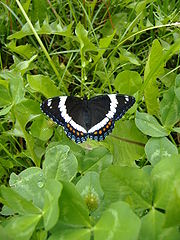
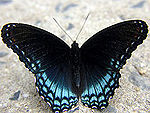
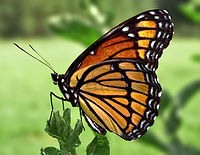
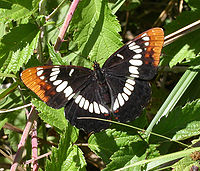
- Red-spotted Admiral, Limenitis arthemis
- White Admiral, Limenitis arthemis arthemis
- Red-spotted Purple, Limenitis arthemis astyanax
- Viceroy, Limenitis archippus
- Weidemeyer's Admiral, Limenitis weidemeyeriiLimenitis weidemeyeriiThe Weidemeyer's Admiral is a butterfly from the Nymphalinae subfamily, in western North America.-Distribution:...
- Lorquin's Admiral, Limenitis lorquini
- Band-celled Sister, Adelpha fessoniaAdelpha fessoniaThe Band-celled Sister or Mexican Sister is a species of butterfly of the Nymphalidae family. It is found in Panama north through Central America to Mexico. It is a periodic resident in the lower Rio Grande Valley, Texas....
- California Sister, Adelpha bredowii
- Eyed Sister, Adelpha paroeca
- Spot-celled Sister, Adelpha basiloides
- Mexican Sister, Adelpha diazi
- Rayed Sister, Adelpha lycorias melanthe
- Common Banner, Epiphile adrasta
- Orange Banner, Temenis laothoe
- Mexican Bluewing, Myscelia ethusaMyscelia ethusaThe Mexican Bluewing or simple Blue Wing is a species of butterfly of the Nymphalidae family. It is found from Colombia north through Central America to Mexico. Strays can be found up to the lower Rio Grande Valley of Texas in the United States.The wingspan is . There are many generations per...
- Blackened Bluewing, Myscelia cyanathe
- Whitened Bluewing, Myscelia cyanirisMyscelia cyanirisThe Blue Wave Butterfly, Blue-banded Purplewing, Tropical Blue Wave, Whitened Bluewing or Royal Blue is a butterfly of the Nymphalidae family.-Description:...
- Dingy Purplewing, Eunica monima
- Florida Purplewing, Eunica tatila
- Four-spotted Sailor, Dynamine postverta
- Blue-eyed Sailor, Dynamine dyonis
- Small-eyed Sailor, Dynamine artisemia
- Orange-striped Eighty-eight, Diaethria pandama
- Common Mestra, Mestra amymone
- Red Rim, Biblis hyperiaBiblis hyperiaThe Red Rim or Crimson-banded Black is a species of Nymphalidae found in Central America they sometimes stray as far north as Texas, also known as the Crimson-banded black. They can be seen flying between March and November in subtropical forest...
- Red Cracker, Hamadryas amphinomeHamadryas amphinomeHamadryas amphinome is a species of cracker butterfly in the family Nymphalidae. It is found from Argentina, Mexico south to Amazon Basin and in Guianas, Peru and Bolivia.The larvae feed on Dalechampia scandens.-Subspecies:...
- Gray Cracker, Hamadryas februa
- Variable Cracker, Hamadryas feroniaHamadryas feroniaHamadryas feronia is a species of cracker butterfly in the family Nymphalidae. It is found in the southern parts of the United States south to Brazil.-Subspecies:*Hamadryas feronia feronia...
- Glaucous Cracker, Hamadryas glauconome
- Pale Cracker, Hamadryas amphichloe
- Guatemalan Cracker, Hamadryas guatemalenaHamadryas guatemalenaThe Guatemalan Cracker or Guatemalan Calico is a butterfly of the family Nymphalidae. It is found in Southern North America ranging to Central South America....
- Black-patched Cracker, Hamadryas atlantis
- Orion Cecropian, Historis odius
- Tailed Cecropian, Historis acheronta
- Blomfild's Beauty, Smyrna blomfildia
- Waiter Daggerwing, Marpesia coresia
- Many-banded Daggerwing, Marpesia chiron
- Ruddy Daggerwing, Marpesia petreusMarpesia petreusThe Ruddy Daggerwing, Marpesia petreus, is a species of butterfly of the Nymphalidae family. It is found in Brazil north through Central America, Mexico, and the West Indies to southern Florida. Strays north to Arizona, Colorado, Nebraska, Kansas, and South Texas.The wingspan is 70–95 mm.The...
- Antillean Daggerwing, Marpesia eleucheaMarpesia eleucheaThe Antillean Daggerwing is a species of butterfly of the Nymphalidae family. It is found in the West Indies. Occasional strays can be found on Florida Keys.The wingspan is 67-83 mm...
Subfamily Charaxinae: Leafwings
- One-spotted Prepona, Archaeoprepona demophonArchaeoprepona demophonThe One-spotted prepona, Archaeoprepona demophon, is a butterfly belonging to the Nymphalidae family.-Description:The wingspan reaches about . The uppersides of the wings is black, with bright pale blue transverse bands...
- Tropical Leafwing, Anaea aideaAnaea aideaAnaea aidea, commonly known as the Tropical Leafwing, is a species of brush-footed butterfly in the subfamily Charaxinae. Its native range extends from Mexico to northwestern Costa Rica, with strays sometimes seen in southern Texas, Arizona, and California in the United States...
- Florida Leafwing, Anaea floridalis
- Goatweed Leafwing, Anaea andria
- Pointed Leafwing, Anaea eurypyle
- Angled Leafwing, Anaea glycerium
- Pale-spotted Leafwing, Anaea pithyusa
- Guatemalan Leafwing, Anaea forreri
Subfamily Apaturinae: Emperors

- Hackberry Emperor, Asterocampa celtisAsterocampa celtisThe Hackberry Emperor is a North American butterfly that belongs to the family of brushfooted butterflies, Nymphalidae.-Description:...
- Empress Leilia, Asterocampa leilia
- Tawny Emperor, Asterocampa clyton
- "Cream-banded" Dusky Emperor, Asterocampa idyja argus
- Pavon Emperor, Doxocopa pavon
- Silver Emperor, Doxocopa laure
Subfamily Morphinae: Morphos
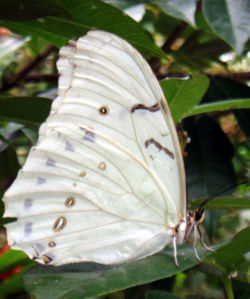
- Orange Owlet, Opsiphanes boisduvalii
- Split-banded Owlet, Opsiphanes cassina
- White Morpho, Morpho polyphemusMorpho polyphemusThe White Morpho is a white butterfly of Mexico and Central America, ranging as far south as Costa Rica. As suggested by its name, this is one of the relatively few morphos that is white rather than blue. Some authorities include M. luna, which is also white, as a subspecies of M...
Subfamily Satyrinae: Satyrs
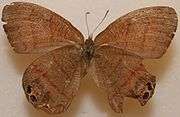
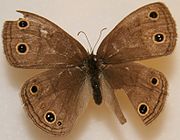
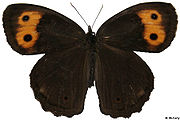

- Southern Pearly-eye, Enodia portlandiaEnodia portlandiaThe Southern Pearly Eye, Portland Pearlyeye or just Pearly Eye is a butterfly of the Nymphalidae family. It is found from eastern Oklahoma and eastern Texas east through the south-eastern United States....
- Northern Pearly-eye, Enodia anthedonEnodia anthedonThe Northern Pearly-eye is a species of Satyrinae that occurs in North America, where it is found from central Saskatchewan and eastern Nebraska east to Nova Scotia, south to central Alabama and Mississippi....
- Creole Pearly-eye, Enodia creolaEnodia creolaThe Creole Pearly Eye is a butterfly of the Nymphalidae family. It is found from North Carolina and central Georgia west to eastern Oklahoma and eastern Texas....
- Eyed Brown, Satyrodes eurydiceSatyrodes eurydiceThe Eyed Brown or Marsh Eyed Brown is a species of Satyrinae that is native to North America.There are two subspecies—the nominate species, Eyed Brown , and the Smokey Eyed Brown The Eyed Brown or Marsh Eyed Brown (Satyrodes eurydice) is a species of Satyrinae that is native to North...
- Appalachian Brown, Satyrodes appalachiaSatyrodes appalachiaThe Appalachian Brown or Woods Eyed Brown is a species of Satyrinae that is native to North America.Wingspan: 39 to 51 mm.Larvae on Rhynchospora inundata, Carex lacustris, and Carex stricta....
- Nabokov's Satyr, Cyllopsis pyracmon
- Horsetail Gemmed-Satyr, Cyllopsis pseudopephredo
- Canyonland Satyr, Cyllopsis pertepida
- Gemmed Satyr, Cyllopsis gemmaCyllopsis gemmaThe Gemmed Satyr is a species of butterfly of the Nymphalidae family. It is found in the South-Eastern United States and North-Eastern Mexico.The wingspan is 35–43 mm...
- Carolina Satyr, Hermeuptychia sosybiusHermeuptychia sosybiusThe Carolina Satyr is a butterfly of the Nymphalidae family. It is found from southern New Jersey south along the coast to southern Florida, west to south-eastern Kansas, central Oklahoma and central Texas. It is also found in Mexico.The wingspan is 32-38 mm. The upperside is brown without markings...
- Georgia Satyr, Neonympha areolata
- Mitchell's Satyr, Neonympha mitchelliiNeonympha mitchelliiCommon names: Mitchell's Satyr, Mitchell's Marsh SatyrThe Mitchell's Satyr is a federally endangered species and it is illegal to collect.-Description:...
- Helicta Satyr, Neonympha helicta
- Little Wood-Satyr, Megisto cymelaMegisto cymelaThe Little Wood Satyr is a species of Satyrinae that occurs in North America.-Description:AdultThe wingspan is 29–48 mm. The forewing has two yellow-rimmed black spots on both sides, dorsal and ventral. The hindwing has two spots on the dorsal side but have smaller spots on the ventral...
- Red Satyr, Megisto rubricata
- Pine Satyr, Paramacera allyniParamacera allyniThe Arizona Pine Satyr is a butterfly of the Nymphalidae family. It is found from the mountains in south-eastern Arizona to Mexico....
- White Satyr, Pareuptychia ocirrhoe
- Hayden's Ringlet, Coenonympha haydenii
- Common Ringlet, Coenonympha tullia
- "Inornate" Common Ringlet, Coenonympha tullia inornata
- "Salt Marsh" Common Ringlet, Coenonympha tullia nipisiquit
- "Ochre" Common Ringet, Coenonympha tullia ochracea
- "California" Common Ringlet, Coenonympha tullia california
- Common Wood-Nymph, Cercyonis pegala
- Mead's Wood-Nymph, Cercyonis meadii
- Great Basin Wood-Nymph, Cercyonis stheneleCercyonis stheneleThe Great Basin Wood-nymph is a North American butterfly in the family Nymphalidae.- Description :Dark brown with two eyespots on the forewing with the upper larger than the lower....
- Small Wood-Nymph, Cercyonis oetusCercyonis oetusThe Small Wood-nymph or Dark Wood-nymph is a butterfly of the Nymphalidae family. It is found in Eastern North America.The wingspan is 32–45 mm...
- Vidler's Alpine, Erebia vidleri
- Ross's Alpine, Erebia rossii
- Disa Alpine, Erebia disa
- Taiga Alpine, Erebia mancinus
- Magdalena Alpine, Erebia magdalena
- Banded Alpine, Erebia fasciata
- Red-disked Alpine, Erebia discoidalis
- Theano Alpine, Erebia theano
- Four-dotted Alpine, Erebia dabanensis (includes youngi)
- Common Alpine, Erebia epipsodeaErebia epipsodeaThe Common Alpine is a member of the Satyrinae subfamily of Nymphalidae. It is found from Alaska south through the Rocky Mountains to northern New Mexico and east across the prairie provinces to southwest Manitoba....
- Colorado Alpine, Erebia calliasErebia calliasThe Colorado Alpine is a member of the Satyridae subfamily of Nymphalidae. It is found in alpine Wyoming and Colorado in the Rocky Mountains as well as various mountain ranges in eastern Asia....
- Reddish Alpine, Erebia kozhantshikovi (includes lafontainei)
- Eskimo Alpine, Erebia occulta
- Red-bordered Satyr, Gyrocheilus patrobas
- Riding's Satyr, Neominois ridingsii
- Great Arctic, Oeneis nevadensisOeneis nevadensisOeneis nevadensis is a species of butterfly in the family Nymphalidae. It is commonly known as the Great Arctic, the Nevada Arctic, the Great Grayling, Felder's Arctic, and the Pacific Arctic. It is native to northwestern North America.-Subspecies:* Oeneis nevadensis nevadensis Oeneis nevadensis is...
- Macoun's Arctic, Oeneis macounii
- Chryxus Arctic, Oeneis chryxusOeneis chryxusCommon names: Chryxus Arctic, Brown ArcticThe Chryxus Arctic is a butterfly, a species of Satyrinae that occurs in North America.-Description:...
- "Brown" Chryxus Arctic, Oeneis chryxus chryxus
- "California" Chryxus Arctic, Oeneis chryxus ivallda
- Uhler's Arctic, Oeneis uhleri
- Alberta Arctic, Oeneis albertaOeneis albertaThe Alberta Arctic is a butterfly of the Nymphalidae family. It is found from the Canadian prairie provinces east to southern Manitoba. Isolated populations are found along the Rocky Mountains in Colorado, New Mexico and Arizona....
- White-veined Arctic, Oeneis taygete (distinct from Old World Oeneis bore)
- Jutta Arctic, Oeneis juttaOeneis juttaThe Jutta Arctic or Baltic Grayling is a species of butterflies in the subfamily Satyrinae with a circumboreal distribution. It occurs in bogs and tundra in the north of Europe, the Baltic States, the Urals, Siberia, Northern Kazakhstan, the Russian Far East, Northern Mongolia, Northeastern China,...
- Sentinel Arctic, Oeneis alpinaOeneis alpinaOeneis alpina, the sentinel arctic or Eskimo arctic, is a species of butterfly in the subfamily Satyrinae. It occurs in Siberia and the northern parts of North America.-Description:...
(includes exubitor) - Melissa Arctic, Oeneis melissa
- Polixenes Arctic, Oeneis polixenes
- Early Arctic, Oeneis rosovi (includes philipi)
Subfamily Ithomiinae: Clearwings
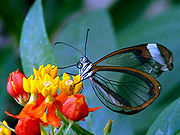
- Klug's Clearwing, Dircenna klugii
- Disturbed Tigerwing, Mechanitis polymniaMechanitis polymniaThe Orange-spotted Tiger Clearwing, Mechanitis polymnia, is a butterfly of the family Nymphalidae. It is found from Mexico to the Amazon Rainforest. The wingspan is...
- Broad-tipped Clearwing, Pteronymia cotytto
- Thick-tipped Greta, Greta morganeGreta morganeGreta morgane, also called the "Thick-tipped Greta," is a day active ithomiine butterfly from the subfamily Ithomiinae. The length of the wings of this clearwing butterfly range from 56 to 58 mm. It is a common butterfly in Mexico, Middle-America, and the Caribbean...
Subfamily Danainae: Milkweed Butterflies
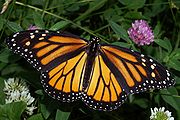
- Monarch, Danaus plexippus
- Queen, Danaus gilippus
- Soldier, Danaus eresimusDanaus eresimusThe Soldier or Tropical Queen, , is a North and South American butterfly in the family Nymphalidae. Their flight is slow and they are reasonably easy to approach, but will fly for some distance if approached too closely....
- Tiger Mimic-Queen, Lycorea cleobaea

